
Zamboanga del Sur, officially the Province of Zamboanga del Sur, is a province in the Philippines located in the Zamboanga Peninsula region in Mindanao. Its capital is the city of Pagadian. Statistically grouped with Zamboanga del Sur is the highly urbanized City of Zamboanga, which is geographically separated and a chartered city and governed independently from the province.

Sulu, officially the Province of Sulu, is a province of the Philippines in the Sulu Archipelago and part of the Bangsamoro Autonomous Region in Muslim Mindanao (BARMM).

The Tausūg, are an ethnic group of the Philippines and Malaysia. A small population can also be found in the northern part of North Kalimantan, Indonesia. The Tausūg are part of the wider political identity of Muslim Filipinos of western Mindanao, the Sulu archipelago, and southern Palawan, collectively referred to as the Moro people. The Tausugs originally had an independent state known as the Sultanate of Sulu, which once exercised sovereignty over the present day provinces of Basilan, Palawan, Sulu, Tawi-Tawi, Zamboanga City, North Kalimantan and the eastern part of the Malaysian state of Sabah. They are also known in the Malay language as Suluk.

Okir, also spelled okil or ukkil, is the term for rectilinear and curvilinear plant-based designs and folk motifs that can be usually found among the Moro and Lumad people of the Southern Philippines, as well as parts of Sabah. It is particularly associated with the artwork of the Maranao and Sama (Badjao) tribes, although it can also be found to a lesser extent among the Maguindanao, Iranun, Tausug, Yakan, and Lumad groups. The design elements vary among these ethnic groups, with the greatest refinement being found among the Maranao.
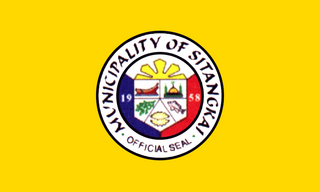
Sitangkai, officially the Municipality of Sitangkai, is a 1st class municipality in the province of Tawi-Tawi, Philippines. According to the 2020 census, it has a population of 37,319 people.

The Sama-Bajau include several Austronesian ethnic groups of Maritime Southeast Asia. The name collectively refers to related people who usually call themselves the Sama or Samah ; or are known by the exonym Bajau. They usually live a seaborne lifestyle and use small wooden sailing vessels such as the perahu, djenging (balutu), lepa, and vinta (pilang). Some Sama-Bajau groups native to Sabah are also known for their traditional horse culture.
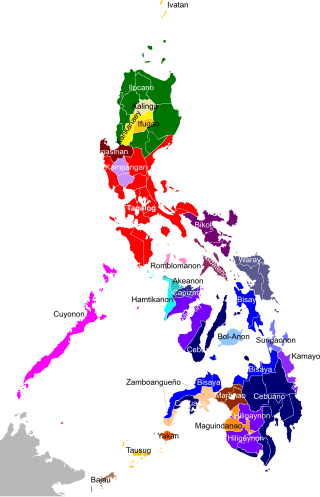
The Philippines is inhabited by more than 182 ethnolinguistic groups, many of which are classified as "Indigenous Peoples" under the country's Indigenous Peoples' Rights Act of 1997. Traditionally-Muslim peoples from the southernmost island group of Mindanao are usually categorized together as Moro peoples, whether they are classified as Indigenous peoples or not. About 142 are classified as non-Muslim Indigenous People groups, and about 19 ethnolinguistic groups are classified as neither indigenous nor moro. Various migrant groups have also had a significant presence throughout the country's history.
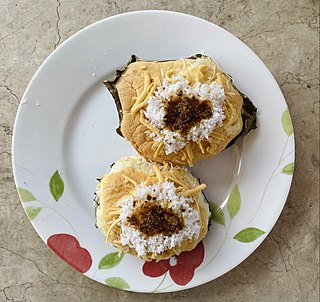
Bibingka commonly refers to a type of baked rice cake from the Philippines that is traditionally cooked in a terracotta oven lined with banana leaves and is usually eaten for breakfast or as merienda especially during the Christmas season.

The Yakan people are among the major indigenous Filipino ethnolinguistic groups in the Sulu Archipelago. Having a significant number of followers of Islam, it is considered one of the 13 Moro groups in the Philippines. The Yakans mainly reside in Basilan but are also in Zamboanga City. They speak a language known as Bissa Yakan, which has characteristics of both Sama-Bajau Sinama and Tausug. It is written in the Malayan Arabic script, with adaptations to sounds not present in Arabic.

The vinta is a traditional outrigger boat from the Philippine island of Mindanao. The boats are made by Sama-Bajau, Tausug and Yakan peoples living in the Sulu Archipelago, Zamboanga peninsula, and southern Mindanao. Vinta are characterized by their colorful rectangular lug sails (bukay) and bifurcated prows and sterns, which resemble the gaping mouth of a crocodile. Vinta are used as fishing vessels, cargo ships, and houseboats. Smaller undecorated versions of the vinta used for fishing are known as tondaan.
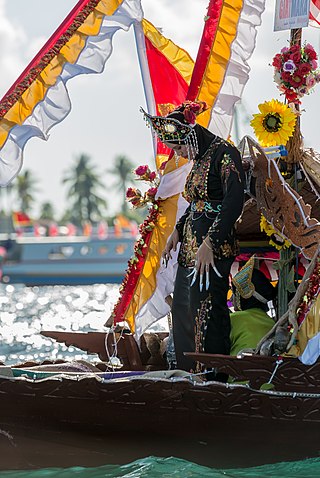
Pangalay is the traditional "fingernail" dance of the Tausūg people of the Sulu Archipelago and eastern coast Bajau of Sabah.

Kinilaw is a raw seafood dish and preparation method native to the Philippines. It is also referred to as Philippine ceviche due to its similarity to the Latin American dish ceviche. It is more accurately a cooking process that relies on vinegar and acidic fruit juices to denature the ingredients, rather than a dish, as it can also be used to prepare meat and vegetables. Kinilaw dishes are usually eaten as appetizers before a meal, or as finger food with alcoholic drinks. Kinilaw is also sometimes called kilawin. In the northern Philippines, grilled meat dish is also known as kilawin.

Pinaypay is a type of banana fritter from the Philippines. It is usually made from saba bananas. The most common variant is prepared by coating thinly sliced and "fanned" bananas in batter and deep frying them. They are then sprinkled with sugar. Though not traditional, they may also be served with slices of jackfruit preserved in syrup or ice cream. Pinaypay are commonly sold as street food and food sellers at outdoor though they are also popular as home-made merienda snacks among Filipinos.
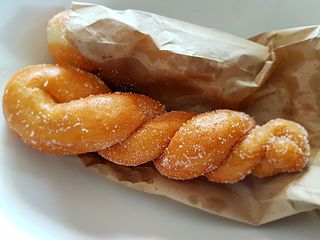
Shakoy, also known as lubid-lubid, is a traditional Filipino deep-fried twisted doughnut. It is traditionally made with flour, sugar, salt, and yeast and deep-fried. It is then sprinkled with white sugar. Variants of shakoy can also be made with other kinds of flour, most notably with rice flour, which results in a chewier version that is also usually coated with sesame seeds. Dry and crunchy versions of shakoy, which are usually much smaller, are known as pilipit.

Biko is a sweet rice cake from the Philippines. It is made of coconut milk, brown sugar, and sticky rice. It is usually topped with latik. It is a type of kalamay dish and is prepared similarly, except the rice grains are not ground into a paste. They are also sometimes packaged and sold as suman.
Lokot-lokot or Locot-locot is a delicacy common in Mindanao and the Sulu Archipelago in the Philippines. It is also referred to as jaa in Sulu; tagaktak, tinagtag, tinadtag, or tinagaktak in Maguindanao, and amik in Davao del Sur. Its texture is crunchy, usually colored golden-brown. Lokot-Lokot is usually produced and served on special occasions such as the Muslim feast of Eid al-Fitr.

Pusô or tamu, sometimes known in Philippine English as "hanging rice", is a Filipino rice cake made by boiling rice in a woven pouch of palm leaves. It is most commonly found in octahedral, diamond, or rectangular shapes, but it can also come in various other intricately woven complex forms. It is known under many different names throughout the Philippines with numerous variations, but it is usually associated with the street food cultures of the Visayan and Moro peoples.
Kumukunsi is a traditional Filipino deep-fried doughnut originating from the Maguindanao people. It is made from rice flour, duck eggs, and sugar. It is traditionally fried into spiral shapes. It has a creamy flavor, similar to pancakes.
Daral, also known as darar, is a Filipino dessert crêpe rolled into a cylinder and filled with sweetened coconut meat (hinti). It originates from the Tausug people of the Philippines. It is also known as balolon among the Maranao people. The crêpe wrapper is similar to the lumpia wrapper, except that it uses batter made from unsweetened ground glutinous rice with coconut milk (galapong). The wrap is sometimes flavored with pandan leaves. However, modern versions can use flour.
Kulibo is a small wooden motorized traditional fishing boat with short double outriggers used by Tausug, Sama-Bajau, and Yakan people of the Philippines.


















